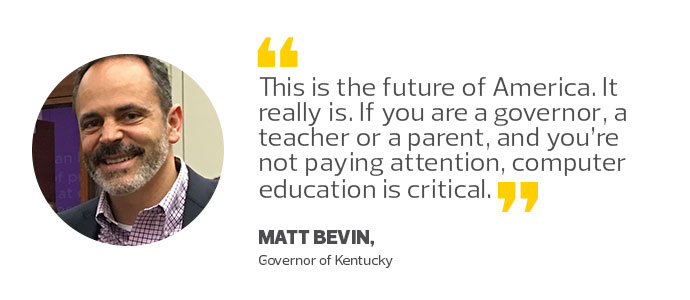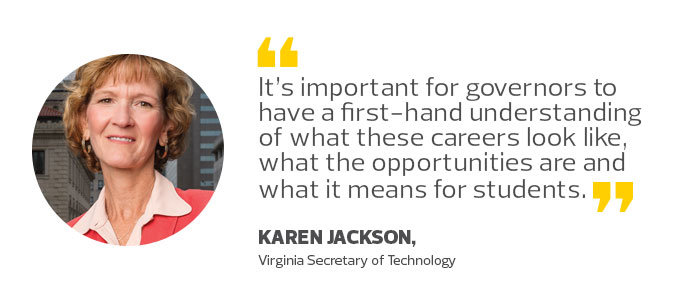Governors Get a First-Hand Lesson in Coding
A group of state governors recently spent an hour learning how to code. And the experience not only gave them a first-hand look at Minecraft, a game that has mesmerized many of today’s youth, it also strengthened their belief that computer science is the future.
In July, seven governors and one lieutenant governor sat down with a group of students for a one-hour workshop on software development during the National Governors Association (NGA) meeting in Des Moines, Iowa. In that hour, the students, some as young as 10 years old, taught the government leaders basic concepts on how to code.
“These kids are inspirational,” said Kentucky Gov. Matt Bevin, during the event, which was captured on a Facebook Live video by Code.org, one of the workshop’s organizers. “This is the future of America. It really is. If you are a governor, a teacher or a parent, and you’re not paying attention, computer education is critical.”
Code.org is a three-year-old, nonprofit organization whose goal is to expand access to computer science education in K–12 schools and encourage girls and students of color to participate.
The organization, which provides professional development for teachers, holds “Hour of Code” events to provide everyone, from students to policy makers, an introduction to coding. In fact, during an Hour of Code event in 2014, President Obama became the first ever president to write a line of code.

Push to Increase Computer Science Learning
Code.org Chief Operating Officer Cameron Wilson said the organization’s goals for state governments are three-fold: require all high schools to offer at least one computer science course; fund computer science professional learning opportunities for K–12 teachers to prepare them to teach rigorous courses; and develop high-quality K–12 computer science standards.
“There’s definitely a need to educate policy makers about why computer science should be taught in schools,” Wilson said in a recent interview. “It’s a relatively a new subject in K–12. Schools have been focused on English, Social Studies, history and math for a couple of hundred years, and computer science as a formal discipline since the ’60s. It takes a while for our institutions to absorb new ideas and subjects like computer science.”
The governors’ workshop on coding furthers the cause because it builds awareness. Governors get a hands-on look at what computer science is about, so they can champion the need for computer science education in their states, said Virginia Secretary of Technology Karen Jackson.
“It’s important for governors to have a first-hand understanding of what these careers look like, what the opportunities are and what it means for students,” she said. “It puts them in a better position to become an effective advocate.”
Governors Learn to Code
Connecticut Gov. Dannel Malloy and Utah Gov. Gary Herbert were among the state leaders who took part in the NGA Hour of Code event. Students who currently take computer science courses in their schools flew in from several states, including Maryland, Virginia and Utah.
During the session, the students huddled with the governors in front of Microsoft Surface Pro tablets and guided them through a Minecraft tutorial.
The tutorial, featuring 14 levels of puzzles, required the governors to program their Minecraft characters to complete a variety of tasks, including chopping down trees and building a home. They used block-based programming to code.
“I just wrote two lines of code. It’s my first ever line of code,” Maryland Gov. Larry Hogan said happily as he fist-bumped a 10-year-old student who taught him how to do it.
Nearby, Virginia Gov. Terry McAuliffe, who recently signed a bill making computer science (including coding) a core academic requirement in his state’s K–12 schools, was also ecstatic as he went through the coding exercise.
“We just did it. I was very effective in getting it done,” he said in the Facebook Live video. “We moved forward and ran through that wall.”

Progress In Many States
Many governors like McAuliffe already support computer science education, believing it can drive economic growth and create jobs in their states. In fact, in April, a bipartisan group of 27 governors joined business leaders to ask Congress to provide funding for computer science education.
The NGA Hour of Code event, however, deepened their resolve to support technology education in their states.
“We are going to be implementing this,” said Bevin, the Kentucky governor, in the video. “Some of it will initially be online. Ultimately, the intention is to get this type of training in every single school in the entire commonwealth of Kentucky.”
Iowa Gov. Terry Branstad was impressed with the students who taught the coding lessons, said Branstad’s spokesman Ben Hammes.
“It was very rewarding for him to do it and to see what these kids are learning,” Hammes said in a recent interview. “It was certainly different from the education experience he had growing up.”
Branstad and Iowa Lt. Gov. Kim Reynolds, who also took part in the coding event, are strong proponents of computer science education, Hammes said. In fact, discussions are underway to put guidelines for specific computer science education into future state legislation.
The state began funding Science, Technology, Engineering and Math (STEM) programs five years ago. The state’s STEM Advisory Council, which Reynolds co-chairs, recently published a report that shows that Iowa students who participate in STEM programs score higher on tests and that they are more interested in staying and working in Iowa upon graduation.
“The governor believes coding is an important part of a child’s education,” Hammes said. “In the future, high-quality jobs that will be coming out will require a certain level of computer science and understanding of coding, so he believes it is essential that children learn that early on, so they can get ready for those jobs in the future.”
At the NGA event, Arkansas Gov. Asa Hutchinson recalled making software coding a signature issue of his campaign before his election in 2014. He recalled that his 11-year-old granddaughter learned to code one summer and built him a mobile app for his campaign.
“I was probably the only candidate in America that’s ever used ‘coding’ in a political ad,” he said.
After his election, the state legislature passed a bill that mandated coding classes be offered in every Arkansas high school. The state also invested $5 million into the effort to train teachers to teach computer science. To foster interest in the subject, students can get math credit for taking a coding class, he added.
“We have right now nearly 4,000 students taking computing coding in Arkansas,” he said. “That’s a 260 percent increase in students taking coding, and the largest area of increase were among minorities and women. The girls are taking coding in Arkansas. They’re excited about it, and we’re expanding on that.”
Moving forward, the state plans to provide more training for teachers and develop K–8 standards in computer science.
“We will continue to invest in it,” Hutchinson said.
As more students study and pursue careers in computer science in the future, Hutchinson says, the state of Arkansas will have “the talent to develop the tech businesses that we need to drive our economy in the future.”









